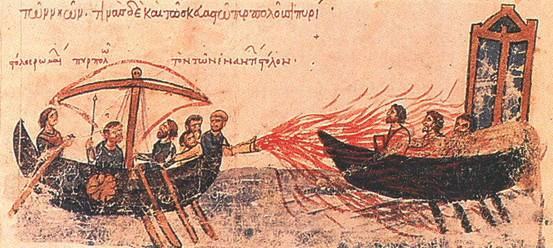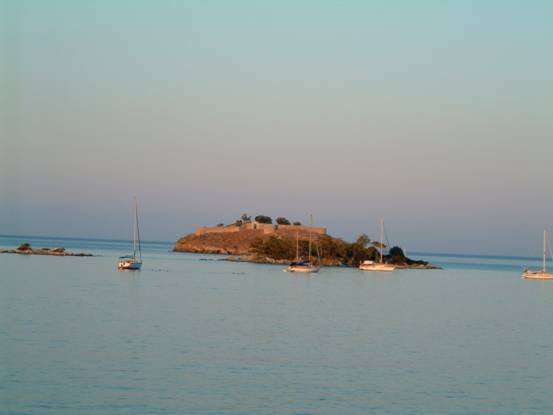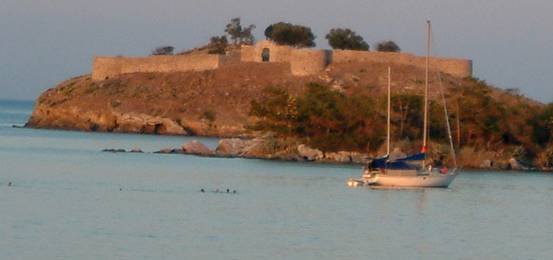
The (Bourtzi) Island Castle and the islet of
Lazaretto which I can see below me, close to Plaka was first
recorded as being built in the times of Byzantium.
In the Dynasty of Heracleus C 600AD, at the similar time of the
Prophet Mohammed. Within 5 years of his death in 623 AD, a wave
of Arabic tribes under the command of Mu’Awiya a close relation
of the Prophet Mohammed himself, invaded Syria, Damascus, Persia
and connecting countries. Also at that time, the Arab fleet took
possession of a string of islands including Rhodes and Chios and
was constantly harassing the Anatolian coast and penetrated into
the Aegean. That is why and when the castle of Agios
Constantine, with its church on the top, was built in 640 AD: to
protect the valuable harbour and the hinterland and olive groves
of Poros, Galatas and Trizinia.
There was also the priceless
thousands of lemon trees and copious springs of water that I can
see if I turn to my right on Belessi hill.
Constans II was the Emperor of the Byzantine Empire and he was busy
defending his borders in Sicily when he was assassinated.
Constantine IV, his son ruled from 668 to 685 having cut off
his two brothers noses and ears or split their tongues, so they
would be ineligible to rule!

Things finally came to a head when, in 674AD the Arab Fleet came
into the Sea of Marmara and right up the city walls of the
capital of Constantinople and tried to storm city. At the same
time Slav army was invading Macedonia. Constantine ordered the
Byzantine fleet to repel the Arabs. They came out with a new
weapon.

A Syrian Greek
Christian refugee from Heliopolis, Kallinicos was Believed to
have Invented this “secret weapon” * in about 673 AD. It was
the first that “Greek Fire,” probably a mix of combustible
Sulphur, oil, Quicklime, naphtha and calcium phosphate. **
Projected through a Syringe (Siphonarios) by bronze pipes, was
used on the sea and the victory was decisive in a naval Battle
nearby the city of Syllaeum in 678AD. The Slavs were defeated
too and for 30 years the Byzantines were not threatened. But
Constantine agreed to pay 3.000 pieces of gold a year.
Through the years the castle of Agios Constantine was owned by
the Venetians and then the Ottoman Turks and was named Bourtzi.
Finally in 1821 with the pent up fury of almost 400 years of
bloody occupation, after the victory of Kalamata and the
massacre of Tripolis where 10,000 Turks were slain, the Greeks
took the whole area in their Battle of Independence with the
help of a coalition of Russian, French and British fleets,
Destroying the Ottoman fleet at the battle of Navarino.

Capodistria the
Governor of the Greece set up his government at Trizinia and
commanded the Bourtzi to be rebuilt in 1827 by a Bavarian, K
Heideck, to defend the fleets. According to the Director of the
Poros Library Iannis Maniatis, the church of Agios Constantine
was still standing, under the supervision of the Monastery of
Zoodochos Pigi. But the Architect Heideck was badly in need of
stone so he dismantled the church on the promise that he would replace it
after the monks had removed all the relics and Icons.

However the church has never been built.
And further embarrassing times were to befall the castle.
Unfortunately in 1831 an argument arose about government
resources and a group of communities including Mani, and Hydra,
with Admiral Miaoulis heading his fleet. The admiral assaulted
the Bourtzi, blew it up and took possession the several ships of
the fleet. However, the Greek Government was reconciled at
Napflion.

And there the castle of Agios Constantine lays, a ghostly echo………
Of sentries on the ramparts trumpet and drum… And of glittering
Roman uniforms (they were Greeks, but they called themselves
Romans). Or perhaps is it an answering bugle call from the
Hellenic Naval Collage at Poros? Sword and Sandal with waving
horsehair helmet, breastplate, spear and shield, atop a golden
Imperial Standard. A Byzantine Galley sailing through.

Peter Pitt July 2005
* Heated in couldrons, the mix of lime,
bones, Charcoal would produce phosphine, which ignited on
contact with water.
** WH Spears 1969. Greek Fire: The Fabulous
secret weapon that saved Europe.
With thanks to Iannis Maniatis, the Director of Poros Library
With thanks to Aris, the great photographer in the sky who took
the birds-eye view pic of Agios Constaninos Castle.
Back






